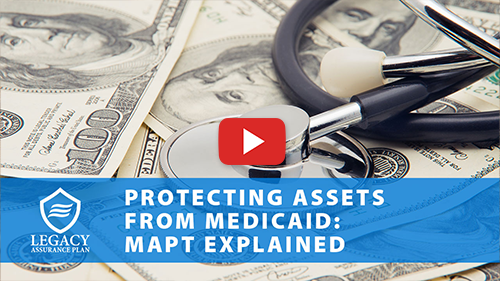A Medicaid Asset Protection Trust (MAPT) is an irrevocable trust designed to shield assets from Medicaid spend down and estate recovery. Rules vary by state, so careful drafting, funding and administration are essential.
MAPTs must pass the “any circumstances” test, meaning if the grantor can benefit from the trust’s assets in any way — directly or indirectly — the assets may be counted for Medicaid eligibility. Even unlikely scenarios can trigger this. Proper structuring is crucial to ensure protection.
How does a MAPT work?
- Asset transfer: Assets such as homes, investments or savings are transferred into the MAPT. These assets are no longer owned by the grantor and are excluded from Medicaid eligibility calculations after a five-year look-back period.
- Trustee oversight: The trustee manages the trust according to its terms. The grantor cannot directly access or control these assets but may retain certain benefits, such as living in a home placed in the trust.
- Medicaid eligibility: Once the look-back period has passed, the assets in the MAPT are protected from being spent down to qualify for Medicaid benefits.
- Estate protection: Upon the grantor’s death, assets in the MAPT are shielded from Medicaid estate recovery programs, ensuring they pass to beneficiaries.
A Medicaid Asset Protection Trust is an essential tool for individuals seeking long-term care coverage without sacrificing their financial legacy. By strategically transferring assets into an irrevocable trust well before care is needed and complying with state-specific rules, families can preserve assets while meeting Medicaid’s strict eligibility requirements.

Comparison of Revocable Trusts and MAPTs
| Estate | RLT | MAPT |
|---|---|---|
| Purpose | Total cost of 3-8% of estate's value | Protecting assets from Medicaid spend down and estate recovery. |
| Flexibility | Takes 12-18 months to complete | Cannot be amended or revoked by grantor. |
| Control | Court file (assets and beneficiaries) is public information | Grantor cannot be trustee and has no access to trust assets. |
| Basis step-up | Yes | Only if grantor is entitled to income. |
| Asset protection for grantors | No | Yes |
| Asset protection for beneficiaries | Yes | Yes |
| Asset considered "countable" by Medicaid | Yes | No, if administered correctly. |
| Grantor can access assets for expenses | Yes | No |
| Grantor can receive income | Yes | Yes |
| Grantor can manage trust investments | Yes | No |
| Assets subject to Medicaid estate recovery | No, in probate-only states. Yes, in expanded estate states. | No, if administered correctly. |
Comparison of Revocable Trusts and MAPTs
RLT
MAPT
RLT
MAPT
RLT
MAPT
RLT
MAPT
RLT
MAPT
RLT
MAPT
RLT
MAPT
RLT
MAPT
RLT
MAPT
RLT
MAPT






